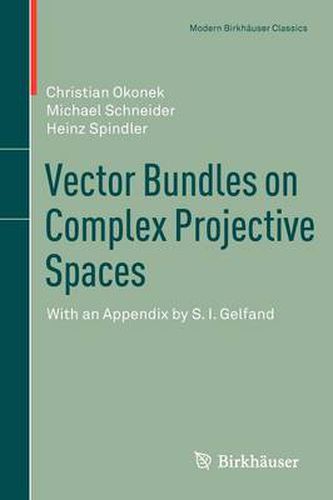Readings Newsletter
Become a Readings Member to make your shopping experience even easier.
Sign in or sign up for free!






This title is printed to order. This book may have been self-published. If so, we cannot guarantee the quality of the content. In the main most books will have gone through the editing process however some may not. We therefore suggest that you be aware of this before ordering this book. If in doubt check either the author or publisher’s details as we are unable to accept any returns unless they are faulty. Please contact us if you have any questions.
These lecture notes are intended as an introduction to the methods of classi?cation of holomorphic vector bundles over projective algebraic manifolds X. To be as concrete as possible we have mostly restricted ourselves to the case X = P . According to Serre (GAGA) the class- n cation of holomorphic vector bundles is equivalent to the classi?cation of algebraic vector bundles. Here we have used almost exclusively the language of analytic geometry. The book is intended for students who have a basic knowledge of analytic and (or) algebraic geometry. Some fundamental results from these ?elds are summarized at the beginning. One of the authors gave a survey in the Seminaire Bourbaki 1978 on the current state of the classi?cation of holomorphic vector bundles over P . This lecture then served as the basis for a course of lectures n in Gottingen in the Winter Semester 78/79. The present work is an extended and up-dated exposition of that course. Because of the - troductory nature of this book we have had to leave out some di?cult topics such as the restriction theorem of Barth. As compensation we have appended to each section a paragraph in which historical remarks are made, further results indicated and unsolved problems presented. The book is divided into two chapters. Each chapter is subdivided into several sections which in turn are made up of a number of pa- graphs. Each section is preceded by a short description of its contents.
$9.00 standard shipping within Australia
FREE standard shipping within Australia for orders over $100.00
Express & International shipping calculated at checkout
This title is printed to order. This book may have been self-published. If so, we cannot guarantee the quality of the content. In the main most books will have gone through the editing process however some may not. We therefore suggest that you be aware of this before ordering this book. If in doubt check either the author or publisher’s details as we are unable to accept any returns unless they are faulty. Please contact us if you have any questions.
These lecture notes are intended as an introduction to the methods of classi?cation of holomorphic vector bundles over projective algebraic manifolds X. To be as concrete as possible we have mostly restricted ourselves to the case X = P . According to Serre (GAGA) the class- n cation of holomorphic vector bundles is equivalent to the classi?cation of algebraic vector bundles. Here we have used almost exclusively the language of analytic geometry. The book is intended for students who have a basic knowledge of analytic and (or) algebraic geometry. Some fundamental results from these ?elds are summarized at the beginning. One of the authors gave a survey in the Seminaire Bourbaki 1978 on the current state of the classi?cation of holomorphic vector bundles over P . This lecture then served as the basis for a course of lectures n in Gottingen in the Winter Semester 78/79. The present work is an extended and up-dated exposition of that course. Because of the - troductory nature of this book we have had to leave out some di?cult topics such as the restriction theorem of Barth. As compensation we have appended to each section a paragraph in which historical remarks are made, further results indicated and unsolved problems presented. The book is divided into two chapters. Each chapter is subdivided into several sections which in turn are made up of a number of pa- graphs. Each section is preceded by a short description of its contents.